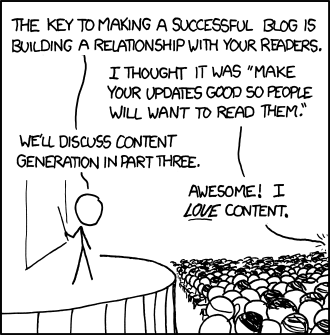Michael Nealis spoke at the 2010 National Conference on Volunteering and Service about how nonprofits can use blogs to reach out to their communities. This a the third of three posts based on his session notes. Check out parts one and two here and here.
Something you’ll have to be aware of once you start writing a blog is that eventually, someone is going to leave a negative comment.
How you handle it is extremely important.
Don’t ignore the comment, and don’t decide to stop writing because of it.
That’s a comment from the Volunteer Maryland blog on an entry about why AmeriCorps isn’t for everyone.
Want to see how it was handled? Check out the blog entry and comments.
You don’t want to ignore a negative comment that someone makes.
The best way to deal with a negative comment is to address the issues that the comment raises, and to do it calmly and insightfully.
If it’s a complaint from someone that your organization has worked with directly, either as a volunteer or a client, this is a good place to open a dialog about what went wrong, and use the opportunity to turn the person into a supporter.
If the negativity continues, continue to address the issues that your organization has control over.
Explain why things work the way they do.
If appropriate, get the commenter in a conversation with the person most directly involved in their complaint. That person may not even know that the complaint was out there, or they may be working to fix the problem already.
Once the situation is resolved, make sure you write about it.Adding a comment to the post where the negative comment was originally posted is fine.
If you feel like your organization has learned something from the conversation and has improved in the area where the complaint was originally made, write a post about it.
Admit that there was some kind of weakness, even if you do the thing the complaint was made about really well, and that the organization is even better now because of it.
Everyone wins. The person’s complaint was resolved, and you’re a better organization.
There are going to be complaints that you can’t do anything about, though. Someone’s going to complain about the weather at an event.
There’s nothing you can do about it, but apologize and invite them out to another event where the weather will be better. It will show that you’re not just dismissing the person’s comments.
Don’t worry, though. Not everyone on the internet is a jerk.
People that are going to find what you write and they’re going to read it.
Rarely will someone leave a negative comment that can’t be resolved positively.
It’s important to know that most of the free blog hosts allow you to monitor comments and approve them before they’re posted to your blog.
This is a perfectly valid way to deal with hurtful and incendiary comments, but you shouldn’t block comments simply because they’re negative. It’s dishonest, and doesn’t allow you to address ill-informed opinions.
You don’t want to spend too much time worrying about negative comments, though. There are a lot of people out there who are going to like what you’re doing, and they’re either going to show their support through page views or positive comments.
Just because no one makes positive comments doesn’t necessarily mean that they don’t like what you’re doing.
It’s been a great opportunity to write these three posts for the HandsOn blog.
There’s so much more to talk about when it comes to blogging that it can’t be addressed all in one place, all at once.
I tried to talk about what I see are three of the most important things about blogging.
There are two really big take home messages, though.
First, content is king and platform doesn’t matter. 
Second, it’s not that hard to do, you can do it. Jump in feet first, you’ll be fine.
If you’ve got a burning question that I didn’t get to address, please feel free to get in touch with me.
You can get in touch with me on , or you can send an . (After August 3, 2010 you can reach me by email .)
Michael Nealis is an AmeriCorps member serving as a Regional Coordinator for Volunteer Maryland, which means he’s a lot like Vanilla Ice. When he’s not busy solving problems, collaborating, and listening, he’s busy supporting Volunteer Maryland’s Volunteer Maryland Coordinators, volunteering with Habitat for Humanity of the Chesapeake, and planning and conducting social media trainings in and around Baltimore.





